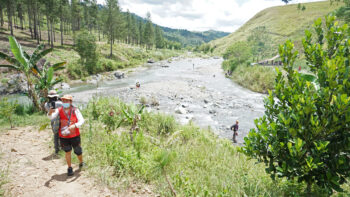
CEBU CITY (MindaNews / 08 April) — Footsteps.
When we walk, we hardly take cognizant of the footsteps we take unless – like the Buddhists – we are so mindful of the here and now, the precious present moment. It is only when one focuses on the movement of his feet while walking down a path, that one is struck with the importance of taking footsteps. For as the Chinese proverb posits: A journey of a thousand miles begins with a single step!
As we celebrate Easter Sunday tomorrow (April 9), it might do as good to reflect on the value of taking footsteps vis-à-vis our faith as followers of the Risen Lord. After all, his admonition – “Come follow me!” – involves literally moving our feet as we go after the Redeemer!
Jesus lived on earth at a time when people could only move from place to place by walking. In some cases, horses and donkeys assisted them as they travelled. Unlike today when the advancement of transportation technology allows us to travel long distance through planes, boats, trains, buses, cars, even the lowly habal-habal, those living in the first century had to rely on their feet if they wanted to be in another place.
Being an itinerant preacher-healer, Jesus himself walked practically all over Israel. While born in Bethlehem, he grew up in Nazareth. When his public life unfolded and he went out to preach the Good News, he travelled from Nazareth to Bethany, Bethesda, Capernaum, Cana of Galilee, Jerico, reaching the Jordan River and the Sea of Galilee. In his three-year public life, he walked more than a thousand miles.
Some of the footsteps he took would take on biblical significance! Among these were those footsteps traversing the desert for forty days when he needed to get ready for his mission, his walk cum ride-the-donkey from the countryside to Jerusalem, his walk across the seashore as he met the fishermen who would become his loyal followers and later when he appeared to them after rising from the dead, and his walk with two forlorn followers on the road to Emmaus.
The most dramatic, of course, were the footsteps he took from the garden of Gethsemane to the palace of King Herod, to the court of Pontius Pilate until he ended up on Calvary Hill. This route – now labelled the Via Dolorosa – has become the focal point of interest for tourists who fortunately find their way in Israel on Good Friday.
On top of this mournful hill, the carpenter from Nazareth – reviled by the Pharisees as a false prophet; who hobnobbed with drunks, sinners and prostitutes; who the powers-that-be considered a rebel out to subvert the established regime and tortured by the Roman soldiers as a means to warn other potential would-be “terrorists,” – was subjected to a crucifixion on a cross, fit for criminals!
That last step Jesus took as he faced death, eventually ended his earthly life.
At dawn of Easter morn, the sound of footsteps echoed across the graveyard where Jesus and others were buried. These were footsteps first of women, later followed by a few of the more courageous apostles curious as to the women’s testimony that the tomb was empty! And most interesting, it was a woman – Magdalene – to whom Jesus first appeared as the Risen Lord!
After Jesus appeared to more of his main followers and trusted disciples, he gathered them together for what is now known as the Great Commission (Matthew 28:19-20) and left them with these words: “Therefore go and make disciples of all nations, baptizing them in the name of the Father and of the Son and of the Holy Spirit, and teaching them to obey everything I have commanded you. And surely I am with you always, to the very end of the age.”
Gifted with the Holy Spirit on Pentecost, many of them, including a new convert – Paul of Tarsus – walked to many directions beyond Israel to give witness to the life and teachings of the Lord. And despite the passage of time and the great advancement of transportation technology, in many Third World countries today, those who bring the Good News to the hinterlands, follow the way of the early disciples. They walk miles to reach the isolated villages.
It is thus, very appropriate that in 2021 Pope Francis inaugurated what would be a synodal Church for these present times. To be a synodal church involves getting all the baptized to journey together as one in the footsteps of the Lord, with great effort exerted to make sure that those who for so long have not been afforded a place in the Lord’s banquet, can finally find themselves in the place of honor!
This was Jesus way; moving from village to village, his focus was to journey with his society’s excluded, the sinners considered unclean and worthless. He avoided the elite, the powers-that-be, the ones who oppressed the poor even as he did not exclude them from his circle if they showed an openness to repent and make amends! He disdained pomp and pageantry, he lived simply without benefit of having a place to stay, comforted the widows and healed the sick. In the process, the Good Shepherd smelt like the sheep!
Alas, when Christianity shifted to Christendom and the Church’s memory of the way of life of Jesus faded, the ugly head of institutionalization and clericalism penetrated the walls of churches, monasteries and convents. Patronized by kings and emperors. ensconced in palaces to enjoy the perks of power, the Church’s heads veered away from the footsteps of the Lord! And the Gospels they preached held no relevance anymore to the lives of the majority who remained in the margins and disenfranchised of their human rights.
If the Church today hopes to return to the dangerous memory of Jesus’ act to save humanity, she has to embrace Pope Francis’ synodal agenda. The question is: how many of our church leaders and engaged laity are making sure that this agenda is not lost in the quaqmire of a Church’s struggle to remain relevant in these post-modern times?
In the VUCA (Volatile, Uncertain, Complex and Ambiguous) reality of the world today, Christianity is faced with a major challenge to return to its roots. Jesus presented the model of a synodal church – his footsteps made possible his journeying with society’s excluded – which challenged an established religion that was hijacked by those who would promote a faith that was blind and obedient to those in power. It was in this context that Christianity was born. If we are to redeem what Jesus founded, we, too, in our times will need to do our best to help build a synodal Church, in spite of the reluctance of our leaders to forge this kind of journey with the rest of us!
Along with Pope Francis, we take the footsteps towards this goal buoyed by the Risen Lord! Happy Easter everyone!
(MindaViews is the opinion section of MindaNews. Redemptorist Brother Karl Gaspar is Mindanao’s most prolific book author. Gaspar is also a Datu Bago 2018 awardee, the highest honor the Davao City government bestows on its constituents. He is presently based in Cebu City).







